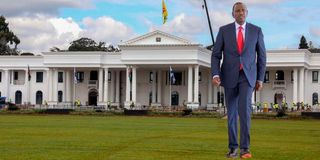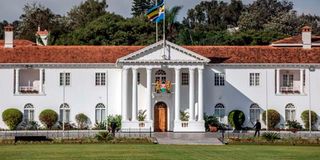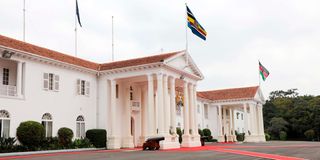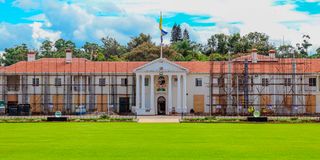
A new look of State House Nairobi that is undergoing renovations in this picture taken on Monday, May 12, 2025.
Behind the gates of Kenya’s most secure residence, construction seems to be the one thing that never stops.
For the past two years, as soon as one structure is done, another is cued in.
State House Nairobi — the seat of executive power — has quietly transformed into a permanent construction zone, well hidden behind manicured lawns and guarded fences. From refurbishments to re-roofing, renovations have been ongoing since President William Ruto took office in 2022, with no end in sight.
Yet, it’s not just the scope of these facelifts that’s drawing attention, but its timing.
President Ruto has raised taxes, slashed subsidies, and cut budgets across nearly every public sector in the name of austerity.
Meanwhile, millions are still being pumped into upgrading the State House and several state lodges across the country.
Budget documents from the National Treasury show that out of the Sh2.3 billion allocated to the Executive Office of the President in the 2025/2026 financial year, a chunk of it will go towards rehabilitation and refurbishment works.
Specifically, State House Nairobi and state lodges will spend Sh894.9 million on rehabilitation works, making for a long-running item in the annual budget.

State House, Nairobi before the renovations.
State House budgets largely cover the affairs and running of State House Nairobi and the various lodges across the country.
According to Treasury documents, State House exists to facilitate the President’s leadership, coordination, and oversight, and to promote good governance. The justification is clear on paper. But public scepticism is mounting.
The Sh894.9 million allocation comes on the heels of a recent overhaul that included altering the iconic colonial-style architecture of State House Nairobi, converting it into a flat-roofed structure. That move alone sparked backlash, including criticism from the Architectural Association of Kenya (AAK).
This spending appears to contradict earlier pledges by the Kenya Kwanza administration to clamp down on luxury and non-essential expenses. That promise became particularly pronounced after a wave of deadly youth protests forced the government to withdraw proposed tax hikes in the Finance Bill 2024.
Interestingly, in the second supplementary budget for 2024/2025, the Treasury had pulled back Sh1.5 billion initially allocated for the facelift.
But this came back in the new budget with Sh894.9 million, including Sh680.7 million specifically for maintenance at State House Nairobi.
The works go beyond Nairobi. State lodges set for general maintenance works over the next financial year starting July 1 include the Eldoret (Sh60.1 million), Sagana (Sh15 million), Mombasa (Sh42.5 million) and Nakuru (Sh25 million).
Others are Kisumu (Sh24 million), Kakamega (Sh25 million), Kisii (Sh12.5 million) and the Mechanical Garage (Sh10 million).
The State House facelifts began in late 2022 after President William Ruto took office following fresh elections and after architects warned that parts of the aged structure had become unfit for habitation and recommended the construction of a new building.

A view of State House in Nairobi.
While some of the State lodges were rarely used by Presidents Mwai Kibaki and Uhuru Kenyatta, President Ruto has made them part of his regular itinerary, hosting meetings in Eldoret, Sagana, and Kisumu.
Defends allocations
The Treasury defends the allocations, saying the funds are essential to support the President’s constitutional mandate.
“In the fiscal year 2025/26 and throughout the medium-term period, the State House will support his excellency in executing the constitutional mandate,” the exchequer said.
While President Ruto’s approach may appear extravagant, he is not the first to put a personal imprint on the presidency’s home.
Former President Uhuru Kenyatta was known for major landscaping and furnishing projects, particularly at Sagana State Lodge, where high-profile meetings were hosted.
In the final two years of his presidency, Mr Kenyatta spent Sh10.7 billion on refurbishment of buildings and infrastructure, according to the Controller of Budget.
Under Dr Ruto’s tenure the government spent Sh122.8 million on renovations in the financial year 2022/2023. In the financial year 2023/2024, the government spent Sh50 million on the refurbishment of buildings and infrastructure in the Office of the President alone, the controller of budget’s documents shows.
Fairly old but with historical significance, the 117-year-old establishment was originally built as the official home of the Governor of the British East Africa Protectorate, but has since served as the official residence of Kenya’s Presidents since independence.
But budgetary allocations to fund State House renovations have elicited mixed reactions. There has been furore about the government’s priorities.
Even MPs have in the past questioned the timing of the facelift expenditures at a time when the exchequer is under pressure to run a lean budget.
“We are spending too much beautifying the State House. If Kenyans are suffering because of budget cuts, the State House should take the lead in tightening its belt,” Kisumu West MP Rozaah Buyu said.
In March, State House Comptroller Katoo ole Metito told MPs that State House renovations were “serviced through the NIS and the Ministry of Defence.”
That did little to calm critics.
Lawyer and activist Joshua Okayo believes the yearly renovations have become a “money-minting machine.”
“State House renovations have become a channel to make money,” he said. “They set aside the budget, do a little work to show something was done, and then steal the rest.”
Mr Okayo argues that these expenditures betray the Kenya Kwanza promise of a people-centred government.
“This is not a people-centered government. If it were, they’d channel that money into services that actually benefit citizens,” he says. “It’s time Kenyans and public interest litigators went to court to seriously oppose such opulence.”
On his part, governance expert Javas Bigambo sees deeper meaning in the renovations.
“There’s symbolism attached to State House. It’s the ultimate seat of power. Beyond the authority of the office, it must also reflect honour,” he says.
Consecutive years
Mr Bigambo adds that for two consecutive years of renovations to be justified, there should have been a clear valuation demonstrating the need — whether it’s for structural integrity, sewer systems, or even cosmetic upkeep.

The ongoing renovations at State House, Nairobi in this picture taken on May 3, 2024.
While all these issues may not come for full disclosure to the public because of even the security aspects, he explains: “It is important for justification to be made that actually a valuation was done to necessitate the renovations.”
However, he cautions that renovations should not be about “imaginary luxury and opulence.”
“The budgetary allocation directed at renovations and refurbishments of the State houses and lodges should not be such kind of renovations that are intended to create an imaginable luxury and opulence for the occupiers,” he says, adding that the President himself has spoken about austerity.
“If we are to be very objective and real, when the State House was first built, it does not mean that the economy of the country was excellent or there was abundance and excesses. The issue is that there is the aspect of the doctrine of necessity. Construction of a state mansion or a state house is a necessary need for the head of government and state,” in the same breath is its renovation, he says, and the economy does not have to be doing well for such renovations to be undertaken.
“The state house is a security installation. What is important is that the security installations should be managed and upgraded in a manner that is not opulent but is reasonably cautious,” he observes.
At the moment, the House on the Hill is among 15 government agencies allocated Sh2.8 billion in supplementary budget III for the 2024/25 financial period, just days to the end of the financial year raising questions about the government’s seriousness to observe fiscal discipline.
Already disbursed
It’s contained in the Sh50.93 billion mini-budget that the National Treasury Cabinet Secretary John Mbadi wants the National Assembly to approve under Article 223 of the Constitution, of which, Sh9.3 billion has already been disbursed.
Curiously, the increased allocations that cumulatively include Sh27.7 billion in recurrent expenditure and Sh23.2 billion in development expenditure, are coming at a time when the government is left with less than two weeks to the end of the financial year.
State House has been a beneficiary of the supplementary estimates this financial year.
In March this year, State House was allocated Sh3.81 billion, which together with the Sh2.8 billion awaiting the MPs’ approval, escalates its global budget for the year to Sh10.92 billion up from the Sh4.31 billion that the National Assembly approved in June 2024.
Of the Sh2.8 billion additional allocation to State House, Sh358.2 million was withdrawn on May 15, 2025, according to the National Treasury schedule.
“Following the approval of the 2024/25 supplementary estimates No. II, the National Treasury has granted additional funding and disbursements to Ministries, Departments and Agencies in accordance with Article 223 of the constitution,” CS Mbadi says in the May 23, 2025 request to the National Assembly.
Additional reporting by David Mwere.








